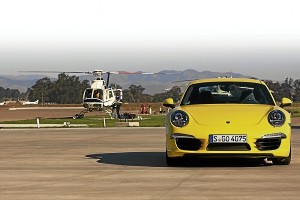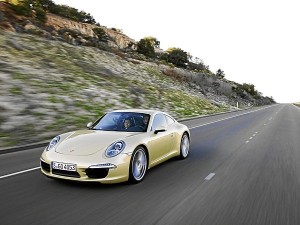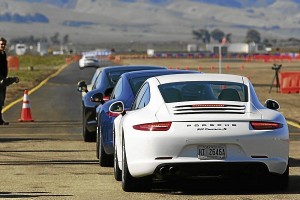Porsche 991 Carrera S is the best 911 yet
So Porsche has come out with a new 911 model, internally code-named 991. The changes from the 993, to the 996, then the 997, and now back to 991 don’t seem to make sense.
Well, owning a sports car has never really made any sense. But a drive inside the new 911 sports car will make you feel that bringing one home makes perfect sense.
The new type-991 is very new indeed, with 95 percent of all parts being new or significantly re-engineered. The car is longer, wider and lower than its predecessor. Key to the new look is the 100 mm longer wheelbase, which does indeed create more interior occupant space but, crucially, increases the 991’s stability at high speed. The front axle track has been widened a total of 50 mm, and the roof is also lower by 10 mm. These don’t seem much, but you can readily feel it. My XL-sized body found it more difficult to get in the newer 991 due to the lower roof, but at speed, Porsche has made huge strides to increase comfort, refinement and luxurious feel, trying to go upscale in the luxury GT Sports coupe segment, competing with the Mercedes SL, Maseratti Gran Turismo, Aston Martin’s V8 Vantage and the Jaguar XK, competitors Porsche didn’t want to name but implied all throughout the press presentation. And from driving through various roads and road conditions in nippy Santa Barbara, Porsche has indeed succeeded in upping the 991’s luxurious feel. Tire and wind noise is appreciably down: at 80 mph you can hear the optional Sports Chrono Pack clock tick as one of the testers commented. Admittedly, all this increase in refinement means you can easily hit 100 mph and enjoy a conversation with your friend and not notice how well past you are the California highway speed limit, the 991 feeling relaxed and stable.
The use of aluminum alloy and other high strength materials have increased by 45 percent from the previous 997 generation, which means that despite the 991 having grown in size and packed with more safety features, weight has gone down considerably by as much as 98 kilograms in certain variants. The diet has also helped increase fuel efficiency by 1.6 liters per 100 kilometers, and having lowered CO2 emissions to below the 200 grams per km level for every km, a level usually reserved for ultra-efficient b-segment cars. The new 7-speed manual, a world first and the PDK dual-clutch transmission now achieve a combined city and highway fuel consumption of 9.5 liters per 100 kms and 8.7 liters per 100 kms respectively, a level again usually reserved for b-segment cars.
More features usually found on hybrids and small cars for increased fuel saving measures include a new electric power-steering, which is significantly lighter than past hydraulic set-ups, but offers a very good amount of feel and ramp-up in effort as speeds increase feels very natural and organic.
The new engines, a 3.4 for the basic Carrera and a 3.6 for the Carrera S, are also much more fuel-efficient and yet pump out more power than their predecessors at higher RPMs. The 3.4 produces 350 hp, up from 340 from the 997, and the Carrera S makes 400 hp, up from 385 from its predecessor, both engines revving to a racier 7,800 rpm redline and yet are very tractable at 2000 rpm in 7th gear to lug the Carrera and Carrera S around town at speeds of below 40 mph.

NOT that this Porsche 991 Carrera S is challenging the chopper to a race, it’s just parked at a runway where the privilege of probing is given to a few, including the Inquirer.
As a testament to all the new technologies added, the Carrera S laps the Northern Loop of the Nurburgring at 7:40 seconds, similar times to a 1st generation 6-speed 997 Turbo and a Mk.1 997 GT3.
The most impressive feature that all future 991 owners will appreciate is the PTV and PTV + torque vectoring system, first seen on the luxurious Panamera 4-door sports limousine. In conjunction with the active hydraulic anti roll-bars and the Porsche Active Suspension Management or PSM, the PTV adjusts roll-stiffness by increasing hydraulic pressure on the outer wheel’s hydraulic roll bar when cornering hard and applying some brakes to the inner wheel to help the rear-end rotate. The PTV +, available with the PDK transmission only, electronically controls differential lock as well to further help rotate the rear end. The feeling is a somewhat lairy rear end that wants to break away completely but ultimately never does, and you end up with a semi-drifting car around tight 3rd gear corners which Porsche’s boffins have judged to be faster around than simply relying on pure mechanical grip. The technology was pioneered in the 997 GT3R Hybrid race cars on the infamous 24 Hour Nurbugring Endurance Race.
At first glance, the changes look small, but they all work and even more people can now appreciate a 911. It’s still easy for mere mortals to drive on both road and track, but still possesses that spinal-tap connection to your senses when going flat out. No wonder Porsche has sold 700,000 911’s since its introduction in 1963.


